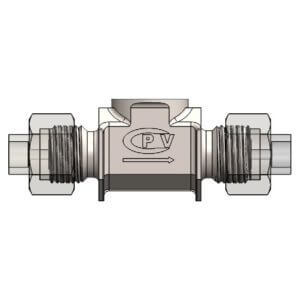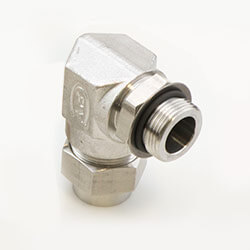“O” Isn’t Always for Obvious—Critical Considerations for Selecting O-Rings that Won’t Fail
A simple component that can cost pennies for a single unit has a ubiquitous presence in industry for more than 100 years, supplying critical seals for valves and pipe fittings in devices and hydraulic systems that enable the existence of modern transportation, manufacturing and more. Invented at the beginning of the 20th century, the O-ring gets its name from its shape, an open circle shaped like the letter “o.”
Its purpose is to provide a mechanical seal that contains liquids or gases when placed in a joint or space between two components, usually made of metal. An O-ring operates under higher pressure environments than other gasket styles. Proper O-ring selection can make a significant difference to workers’ health and safety and the success or failure of industrial systems and machinery.
The Self-Energizing Seal Formed by an O-Ring
O-rings form a seal when squeezed between two adjacent surfaces that are pushed together, usually two metal surfaces. The O-ring sits in a space or joint between these two parts, and as it is compressed it forms a tight seal. The contact stress between the O-ring and the surface needs to be greater than the fluid pressure to prevent the fluid or gas from escaping.

As pressure increases, so does compression on the O-ring, which up to a point, increases contact pressure and improves the O-ring’s sealing power. This positive feedback loop, or the correlation between increased pressure and an increased seal is called “self-energizing.”
O-rings are easy and generally inexpensive to manufacture, small, easy to install and require little to no maintenance. However, for such a simple component, there are several factors that impact O-ring performance and therefore selection, including the application temperature, sealing pressure or psi, chemical compatibility between the gases or liquid being contains and the O-ring polymer or material, and more.
Purchasers can determine an O-ring’s size based on the first three digits of a seven-digit number assigned to each O-ring, given in ANSI/SAE AS568A. The last four digits differ depending on the O-ring manufacturer, but generally indicate the type of material used to make the O-ring.
Material Selection For an O-Ring
Selection and O-ring sizing are paramount considerations for proper O-ring performance.
The selected material compatibility with the flow media, or the gas or liquid passing through the system is critically important to avoid material degradation and O-ring failure. CPV relies on a Parker O-Ring Handbook, which lists thousands of gases and liquids alongside material compatibility to aid with O-ring material selection. The gases and temperatures are cross-referenced with polymers.

1. Temperature range
Each type of material has a low and high limit. The O-ring material selected must match the projected temperature range it could encounter in the system or the surrounding environment to avoid failure.
2. Chemical capability
Alongside temperature range, this could be the most important characteristic when determining O-ring material selection, to avoid incompatibilities that could damage the O-ring and break its seal.
3. Durometer
This defines the hardness or compressibility of the O-ring material. Most O-rings operate within standard range, with nitrile or a rubber O-ring rated at 75, while a Fluorocarbon Viton, a standard at CPV, is rated at 90. The higher the durometer number, the harder the material.
A softer material could be subject to extrusion. CPV generally installs O-rings in the face seal. The Parker handbook also helps specify O-ring types according to connection point, whether within a piston, a ceiling area, a face seal, and so on. The durometer and compressibility desired depend on the application.
4. Gland depth
This defines the clearance or depth of material for an O-ring such that, when subjected to pressure, the O-ring material does not extrude into the gap between pressure points. Extruded O-ring material can fray or degrade, limiting the O-ring’s service life and negating the seal it provides.
5. Cost
O-rings fabricated of standard materials are inexpensive. Specialized materials or larger sizes rise in price, sometimes sharply. Purchasers already aware of supply chain issues, should know that some specialty materials for O-rings are quite limited and plan accordingly.
As one example of a specialty material, FFKM or perfluoroelastomeric compounds, offer improved resistance to chemicals and high temperatures compared to fluoroelastomers, but can cost significantly more. Specialty sizes that require a new mold also increase the price and the timeframe for project completion and delivery.
6. Shelf life
Many materials offer almost unlimited shelf life, for example, O-rings made of fluorocarbon. Others have a 10–15-year shelf life. Once an O-ring is in service, its lifespan depends on the environment.
There could be debris introduced into the system during cleaning or a purge that cuts the O-ring. Caustic materials also can shorten the O-ring’s lifespan. For example, ammonia-based cleaners used within a system will, over time, corrode metals and damage the O-rings.
Proper maintenance and inspections can help extend O-ring serviceability and determine whether it needs replacement, typically an easy process. After some simple lubrication, the O-ring can slip into the groove and seal. A dry seal will never seal as well as one that is lubricated.
Common Causes of O-ring Failure
O-ring manufacturers provide useful information on proper care and selection. There are numerous potential causes of O-ring failure in mechanical systems. These can include:
- Compression set—an elastomeric material flattens, or fails to return to its original size after compression
- Extrusion and nibbling—An O-ring that has edges which protrude outside of the sealed area
- Spiral failure—A seal that is excessively compressed and cuts the O-ring
- Explosive decompression—When high-pressure gas becomes trapped within the internal structure of the seal, the gas expands to match external pressure, causes blisters and ruptures on the O-ring
- Chemical degradation—Incompatibility between the O-ring’s elastomer and chemical exposure
- Thermal degradation—surpassing the high-temperature limit of the elastomeric material and/or compound
- Abrasion
- Improper installation
O-SEAL® and Mark VIII® Union Fittings’ Superior Seal
CPV offers two proprietary union fitting lines: the O-SEAL® and Mark VIII® fittings. These are mirror opposites and therefore not cross compatible for use, with the differences in the thread piece and the tailpiece and positioning of the O-ring groove.
The O-SEAL product line is designed for pipe connections with limited TUBE options, while the Mark VIII product line is designed for tube connections with limited PIPE options.
The Mark VIII line of stainless-steel shutoff and regulating valves offer a soft-seated valve design for trouble-free operations in many industries, such as chemical processing, with the highest tolerances and reliable, leak-proof service. The O-SEAL line offers an ergonomic handle design for greater operator comfort and ease of turning.
Each supplies numerous benefits to the end user.
- Two flat mating surfaces with an O-ring nested between and a respective Union Nut creates a positive bubble-tight seal
- O-rings are fully enclosed and compressed within the completed union, to avoid leaks and to protect the O-ring from potential exposure to caustic substances or damage.
- System integrity is protected with the unique design of CPV O-SEAL and Mark VIII fittings, which do not deform or distort the tubing/piping in a system, as compression or flare fittings can
- Many connection options are available in pipe and tube size
Trust CPV’s vast experience supplying valves and fittings for decades for mission critical operations in military vessels, industrial gas operations and manufacturing, to help match the proper O-ring for your application. For more information, visit our main company site at www.cpvmfg.com.
